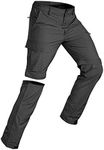Buying Guide for the Best Hiking Clothes For Men
Choosing the right hiking clothes is essential for comfort, safety, and performance on the trail. The right gear can protect you from the elements, regulate your body temperature, and provide the mobility you need for various terrains. When selecting hiking clothes, consider the climate, the duration of your hike, and the type of terrain you'll be encountering. Here are some key specifications to consider when picking hiking clothes for men.MaterialThe material of your hiking clothes is crucial because it affects breathability, moisture-wicking, and durability. Common materials include synthetic fabrics like polyester and nylon, which are lightweight, quick-drying, and wick moisture away from your skin. Merino wool is another excellent option, known for its natural odor resistance and temperature regulation. Cotton should generally be avoided for hiking as it retains moisture and can lead to discomfort and hypothermia in cold conditions. Choose materials based on the weather conditions and your personal comfort preferences.
LayeringLayering is a strategy used to manage body temperature and moisture. It typically involves three layers: a base layer for moisture-wicking, a middle layer for insulation, and an outer layer for protection against wind and rain. The base layer should be snug and made of moisture-wicking material like synthetic fabrics or merino wool. The middle layer, such as fleece or down, provides warmth. The outer layer, often a waterproof or windproof jacket, shields you from the elements. Adjust your layers based on the weather and your activity level to stay comfortable.
FitThe fit of your hiking clothes affects your comfort and mobility. Clothes that are too tight can restrict movement and cause chafing, while clothes that are too loose can get caught on branches or rocks. Look for a fit that allows for a full range of motion without being overly baggy. Consider trying on clothes and moving around in them to ensure they fit well. The right fit will depend on your body type and personal preference, but aim for a balance between comfort and functionality.
BreathabilityBreathability refers to how well a fabric allows moisture and heat to escape. This is important for regulating body temperature and staying dry. Breathable fabrics help prevent overheating and excessive sweating, which can lead to discomfort and chafing. Look for clothes with breathable materials like synthetic fabrics or merino wool, and consider features like ventilation zippers or mesh panels. Choose breathability based on the intensity of your hike and the climate; more breathability is needed for warmer conditions and strenuous activities.
Water ResistanceWater resistance is crucial for staying dry in wet conditions. Hiking clothes can range from water-resistant to fully waterproof. Water-resistant clothes can handle light rain and splashes, while waterproof clothes are designed to keep you dry in heavy rain. Look for features like sealed seams and waterproof zippers for better protection. If you expect wet weather or will be hiking in areas with frequent rain, opt for waterproof gear. For dry conditions, water-resistant clothes may be sufficient.
DurabilityDurability is important for hiking clothes because they need to withstand rough terrain, abrasion, and frequent use. Durable materials like ripstop nylon and reinforced stitching can extend the lifespan of your gear. Consider the type of hiking you'll be doing; more rugged trails require more durable clothing. Check for features like reinforced knees and elbows, and read reviews to gauge the durability of the clothes. Choose durability based on the intensity and frequency of your hikes.
WeightThe weight of your hiking clothes can impact your comfort and energy levels. Lightweight clothes are generally preferred for hiking as they reduce the load you carry and allow for better mobility. However, heavier clothes may offer more warmth and protection. Consider the balance between weight and functionality; for long hikes or warm weather, opt for lightweight gear. For colder conditions or shorter hikes, heavier clothes may be more appropriate.
UV ProtectionUV protection is important for protecting your skin from harmful sun rays, especially at higher altitudes where UV exposure is greater. Some hiking clothes come with built-in UV protection, indicated by a UPF rating. UPF 30 or higher is recommended for effective protection. If you'll be hiking in sunny conditions or at high altitudes, look for clothes with UV protection. This can help prevent sunburn and long-term skin damage.























